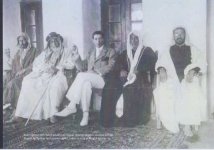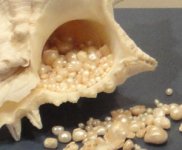Cyril Roger Brossard
Well-known member
- Joined
- Aug 30, 2012
- Messages
- 408
The Epic of Gilgamesh or why Unlike Rolls Royce, Bahraini Pearls Are a Good Investment...
This is a blog authored by Eva the Dragon posted on Feb 2012:

From Left to Right - Yusuf bin Ahmed Kanoo, Salman Mattar, Jacques Cartier, Mugbil Al-Tbukair and a pearl expert
Like Jacques Cartier who came to Bahrain in 1921 looking for pearls, the Japanese have recently been to Bahrain on a pearl quest Dr. Ali Safar confided to us.
Dr. Safar, the Director of the Precious Metals and Gemstone Testing Laboratory in Bahrain, was the key note speaker at a Pearl lecture I attended last week.
Why? Today 95% of the pearls sold worldwide are cultivated in China. Even the Japanese who created the cultured pearl industry have given up against the Chinese onslaught. The only market the Japanese can afford to compete in today are pearls larger than 8mm.
Not to denigrate the quality of cultured pearls, for as Dr. Safar said, “experts with a lot of experience” have difficulty differentiating between a cultured pearl and a natural pearl. The real difference between natural and cultured pearls is its essence – was it created naturally, by chance, or has man manipulated nature in his laboratory for commerce.
Bahraini pearls have not only worn by royalty but “al haka” or extremely small pearls that cannot be drilled are crushed and eaten or used in cosmetics because they are believed to hold the secret to immortality.
Bahraini pearls prized status as “Jiwan” (perfect pearls) began 5,000 years ago when the ancient Sumerians wrote about the two-thirds divine, one-third human, King of Ur, Gilgamesh.
Gilgamesh after losing his beloved friend, the wild man Enkidu, began to worry about his own mortality. He decided to search for Utnapishtim the survivor of the Great Flood to whom the Gods had bestowed immortality. Gilgamesh traveled to Dilmun (Bahrain) where Utnapishtim and his family lived. After some negotiation, Utnapishtim told him the flower (the pearl) of immortality lay at the bottom of the sea. Gilgamesh dove down deep and found the pearl. But when he fell asleep, a snake swallowed it.
The Epic of Gilgamesh gave Bahraini pearls a special magic. But the reason they are the rarest natural pearls in the world is because of the unique natural phenomenon in the Gulf where fresh water springs burst out into the salt water. Unfortunately even Paradise can only support so many people. The seemingly endless fresh water supply has been nearly used up by modern people and industry. Like the rest of the world’s oceans, the Gulf’s sea beds are polluted and have been diminished by government land reclamation.

Similar to diamonds, a pearl’s value is based on its luster, color, shape and size. The larger the pearl, the more valuable it is. The Bahraini pearl’s incredible luster is based on its unique habitat. In Bahrain where Indian traders dominate pearl wholesaling, pearl descriptions are in Hindi. The Indian scale starts with perfect pearls or Jiwan which means beauty.
“Everyone wants Jiwan but they are very rare,” Dr. Safar assured us.
Shireen is next, meaning “sweet” or having very good luster.
Gholwah means “round pearls” or average.
Badlah means irregular shape.
Sihteet are poor to average luster.
Khaka is kaka – in every language I guess – or the lowest quality.
Bahraini pearls range up to twelve different colors depending on the mollusks. A local diver said she noticed the pearl’s color was dependent on where it formed with the pearl’s body.
“Mollusks are like people,” said Dr. Safar. “Some are white and some are yellow.”
In the Gulf region, the mahar mollusks produce the nabati pearls, cream with a reddish hue, which are favored among the Gulf people. The abyadh (white) and gallabi (white with a strong iridescence) are popular with other buyers. The zinni mollusks found in the shallow waters produce the rare colored, more expensive, pearls.
Pearl buying is like buying a used-car.
“If the salesman figures out what you like, you might pay 1,000 dinars when other people will only pay 100. This is life,” counseled Dr. Safar.
The only way to know how that creamy bit of calcium carbonate was created is to x-ray it – at the lab – after purchase.
Despite their small size, Dr. Safar assured us a double stranded, Bahraini pearl necklace was a better investment than a Rolls-Royce.
“A Roll’s value depreciates,” he said nodding at the two Saudis in their elegant thobes, “but a Bahraini pearl only increases in value.”
Since my blog hasn’t made me enough money to buy either a Rolls Royce or a pearl necklace, I am afraid I will have to wait until I reach Paradise where the Koran says the faithful will be adorned in pearls.
This is a blog authored by Eva the Dragon posted on Feb 2012:

From Left to Right - Yusuf bin Ahmed Kanoo, Salman Mattar, Jacques Cartier, Mugbil Al-Tbukair and a pearl expert
Like Jacques Cartier who came to Bahrain in 1921 looking for pearls, the Japanese have recently been to Bahrain on a pearl quest Dr. Ali Safar confided to us.
Dr. Safar, the Director of the Precious Metals and Gemstone Testing Laboratory in Bahrain, was the key note speaker at a Pearl lecture I attended last week.
Why? Today 95% of the pearls sold worldwide are cultivated in China. Even the Japanese who created the cultured pearl industry have given up against the Chinese onslaught. The only market the Japanese can afford to compete in today are pearls larger than 8mm.
Not to denigrate the quality of cultured pearls, for as Dr. Safar said, “experts with a lot of experience” have difficulty differentiating between a cultured pearl and a natural pearl. The real difference between natural and cultured pearls is its essence – was it created naturally, by chance, or has man manipulated nature in his laboratory for commerce.
Bahraini pearls have not only worn by royalty but “al haka” or extremely small pearls that cannot be drilled are crushed and eaten or used in cosmetics because they are believed to hold the secret to immortality.
Bahraini pearls prized status as “Jiwan” (perfect pearls) began 5,000 years ago when the ancient Sumerians wrote about the two-thirds divine, one-third human, King of Ur, Gilgamesh.
Gilgamesh after losing his beloved friend, the wild man Enkidu, began to worry about his own mortality. He decided to search for Utnapishtim the survivor of the Great Flood to whom the Gods had bestowed immortality. Gilgamesh traveled to Dilmun (Bahrain) where Utnapishtim and his family lived. After some negotiation, Utnapishtim told him the flower (the pearl) of immortality lay at the bottom of the sea. Gilgamesh dove down deep and found the pearl. But when he fell asleep, a snake swallowed it.
The Epic of Gilgamesh gave Bahraini pearls a special magic. But the reason they are the rarest natural pearls in the world is because of the unique natural phenomenon in the Gulf where fresh water springs burst out into the salt water. Unfortunately even Paradise can only support so many people. The seemingly endless fresh water supply has been nearly used up by modern people and industry. Like the rest of the world’s oceans, the Gulf’s sea beds are polluted and have been diminished by government land reclamation.

Similar to diamonds, a pearl’s value is based on its luster, color, shape and size. The larger the pearl, the more valuable it is. The Bahraini pearl’s incredible luster is based on its unique habitat. In Bahrain where Indian traders dominate pearl wholesaling, pearl descriptions are in Hindi. The Indian scale starts with perfect pearls or Jiwan which means beauty.
“Everyone wants Jiwan but they are very rare,” Dr. Safar assured us.
Shireen is next, meaning “sweet” or having very good luster.
Gholwah means “round pearls” or average.
Badlah means irregular shape.
Sihteet are poor to average luster.
Khaka is kaka – in every language I guess – or the lowest quality.
Bahraini pearls range up to twelve different colors depending on the mollusks. A local diver said she noticed the pearl’s color was dependent on where it formed with the pearl’s body.
“Mollusks are like people,” said Dr. Safar. “Some are white and some are yellow.”
In the Gulf region, the mahar mollusks produce the nabati pearls, cream with a reddish hue, which are favored among the Gulf people. The abyadh (white) and gallabi (white with a strong iridescence) are popular with other buyers. The zinni mollusks found in the shallow waters produce the rare colored, more expensive, pearls.
Pearl buying is like buying a used-car.
“If the salesman figures out what you like, you might pay 1,000 dinars when other people will only pay 100. This is life,” counseled Dr. Safar.
The only way to know how that creamy bit of calcium carbonate was created is to x-ray it – at the lab – after purchase.
Despite their small size, Dr. Safar assured us a double stranded, Bahraini pearl necklace was a better investment than a Rolls-Royce.
“A Roll’s value depreciates,” he said nodding at the two Saudis in their elegant thobes, “but a Bahraini pearl only increases in value.”
Since my blog hasn’t made me enough money to buy either a Rolls Royce or a pearl necklace, I am afraid I will have to wait until I reach Paradise where the Koran says the faithful will be adorned in pearls.
Last edited:
